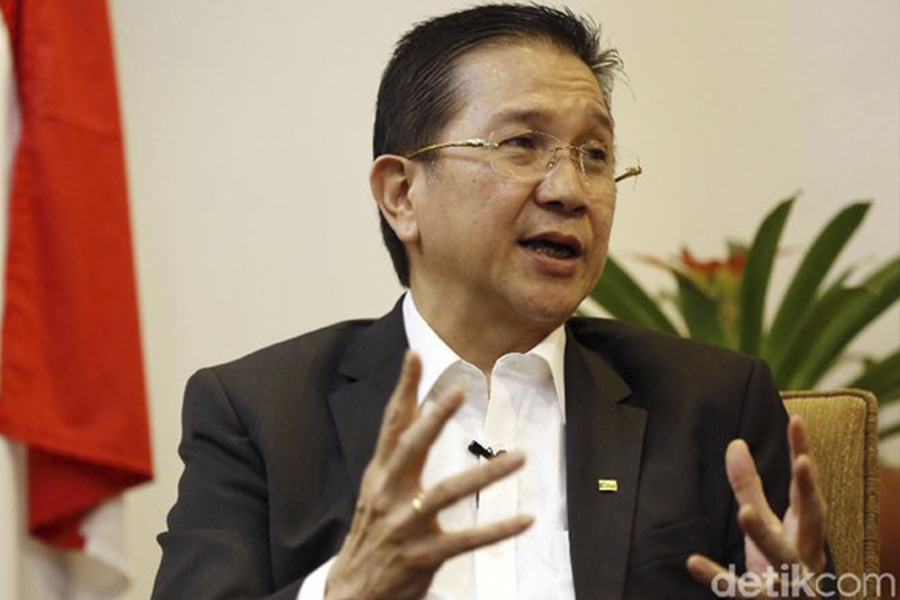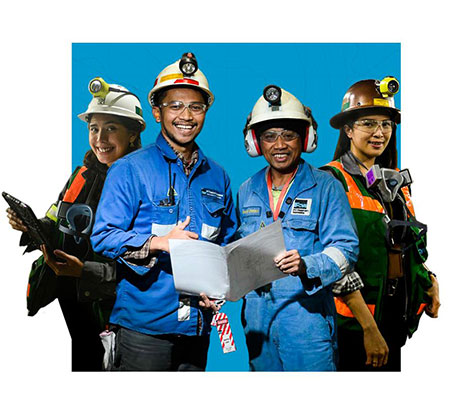05 November 2021

Climate change is currently the world’s sexiest issue. Nations are committed to resolving problems caused by climate change. Various entities are expected to take part in efforts to overcome such problems. Climate change is the topic under discussion at the 26th UN Climate Change Conference of the Parties (COP26) in Glasgow. PT Freeport Indonesia (PTFI) President Director Tony Wenas is similarly responding to this issue, as disclosed to detikcom. "The gist of it is that we in the company along with other companies are making contributions and supporting government efforts to reduce carbon emissions towards putting the brakes on climate change,” he said to detikcom on Thursday (4/11/2021). PTFI’s boss is not just calling attention to climate change, he is also highlighting development of electric vehicles, which the government is galvanizing. This industry needs copper, and one of the minerals Freeport produces is copper. Tony Wenas further spoke out on PTFI’s smelter development in Gresik that has drawn protests from Papuans. Papuans want the smelter to be built on their land. But smelter development is already underway in Gresik.
How was detikcom’s interview with PTFI’s boss? The following is a full rundown. At this time, the world’s sexiest issue is climate change, and even now COP26 is in session. What is PT Freeport’s own part in the climate change issue?
The gist of it is that we in the company along with other companies are contributing to, and supporting government efforts to reduce carbon emissions towards putting the brakes on climate change. As you know, there are NDCs (nationally determined contributions). Of course, companies must play their part to support the government’s goal and in the interests of climate itself, and we play a similarly significant role in running this company such that operations are conducted responsibly, by continually addressing environmental, social and governance (ESG) aspects. ESG aspects must be constantly promoted in consonance, and this includes among other taking measures to reduce carbon emissions.
In concrete terms, PTFI is committed to cutting down carbon emission in its mining operation, from the actual mining activity to smelter operation, and what do these constitute?
In terms of our mining operation, at first PTFI was primarily working on open pit mining; in an open pit huge trucks are used, and these trucks basically consume fossil fuels, diesel oil fuel. But now we have transitioned to underground mining, and this is where we are conducting innovations, by focusing on energy efficiency and automation of our assets. For instance, at the underground Grasberg Block Caving operation, an electric railway is used for transporting ore. The electric rail can carry 300-ton loads just like the 300-ton capacity trucks. Of course, the electric railway significantly reduces carbon emission. In addition, we are building a dual fuel power plant (a power plant that can alternate between using oil and gas as fuel/ pltmg/pembangkit listrik tenaga minyak dan gas). When oil is used, it is B30 biofuel which emission is much lower, and of course emission is also lower with gas usage. We are also looking at possible electrification of our equipment, among others the heavy equipment used in our underground mine, which will lower emissions, therefore furthering our carbon emission reduction effort. To be sure, there are additionally programs for land improvement and rehabilitation that are actively underway. Our commitment is to achieve 30% greenhouse gas emission reduction by the year 2030.
What measures will PTFI take in utilizing new and renewable energy sources? On its part, going forward the government is committed to eliminating fossil energy sources. What about PTFI readiness?
On the matter of renewable energy, we produce copper. 65% of the world’s copper is used to conduct electricity. So, in fact, our copper mining operation supports utilization of renewable energy. Why? Because after energy is produced it must be delivered to consumers, to the public, and this is made through copper. Electric vehicles have nickel in them, their batteries use nickel, and copper is used to conduct the electricity. For example, solar panels or wind farms as well as other renewable energy sources use up 4 to 5 times more energy than fossil fuels. As do electric vehicles use up 4 times more energy than conventional vehicles. Meanwhile, on our part we use cleaner energy with lower emission, through dual fuel, and this is because of the topography at the location where we operate. If we were to use PLTBs (wind energy power plants, the wind would not be sufficient). Furthermore, we are conducting other studies as we will be operating until 2041, our license to operate is effective to 2041. So, we are aligning our efforts with the effective period of our operating license.
The environment is a crucial issue in mining operations as well. In terms of rehabilitation and protection the ecosystem, what are the commitments PTFI is undertaking?
Under our current rehabilitation effort, we are carrying out reclamation of inactive areas, carrying out revegetation, and we have revegetated and reclaimed approximately 1,000 hectares of inactive land. Additionally, we are carrying out replanting in a 3,800-hectare area in Sentani. We have regraded forest areas and are further developing and replanting these regraded areas. We have now planted more than 4 million trees and will be planting even more in the future. In the estuarial area in our operating area, we have replanted and are replanting mangroves, covering 50 to 100 hectares every year. This is part of our environmental management program, towards ensuring protection and conservation of the ecosystem in our operation area. We have also begun replanting on our former Grasberg open pit, which is situated at an elevation of 4,000 meters, where the only vegetation that grow are grasses and bushes. But we have replanted them. Progress in this endeavor has been excellent, as tailings are not toxic, tailings land can be revegetated, fishponds can be built there, all kinds of plants can and have been planted there. In the space of 10 years, we have been able to rejuvenate the area into a young forest.
Electric vehicles were mentioned. Does PTFI see if there are opportunities for Indonesia to play a major part in the electric vehicle industry, and in what way?
Well, we think there are huge opportunities. First, we have the natural resources greatly needed for electric vehicles, we have an abundance of nickel to produce batteries for electric vehicles, and we have massive amounts of copper, and that is attached to electric vehicles, where they are greatly used for their cabling. So, in addition to other minerals that highly support an electric vehicle industry, there is indeed immense opportunity for such an industry to be developed in Indonesia. We are also aware that the government is at this time actively seeking to strike deals with several overseas businesses – not just for battery plants – but also for electric vehicle plants to be developed soon in Indonesia, and again, the chances of this materializing are great, and we are confident this will come about in the near future.
In terms of specifications and quality, does the copper produced by Freeport can be included in the supply chain of the electric vehicle industry? Yes, it does. If you notice now, PT Smelting, which has produced copper cathodes, produces 300 thousand tons per year. If the new copper smelter at JIIPE Gresik can operate, there will be an additional 600 thousand tons of copper cathode, a very large number for the downstream industry, cable factory and so on so that the government can make electric cars and batteries domestically.
The smelter construction, which was recently groundbreaking by President Jokowi in Gresik, was protested by Papuans, 'why was the smelter not built in Papua'. The project implementation pays attention to many aspects, from the economic, location, market, to land as well as port availability. All of which need to be considered. It has been 5 years since we conducted a study to determine the location in several places, including in Papua. From all aspects, the best choice is JIPE in Gresik.
The Minister of Investment and several stakeholders will reportedly fulfill the request of the Papuan people that later a smelter will also be built in Papua. Is it true?
I also heard the same thing that there is indeed a government plan to invite investors to build a copper smelter in Papua according to Mr. Bahlil and of course if our concentrate production is sufficient, we can supply it. This is being discussed together with the Ministry of Investment and the Ministry of SOEs.
How much concentrate production must be to allow a smelter in Papua to be built?
Our production is still being discussed. Mr. Bahlil said that it is now being studied together comprehensively between PTFI, the Ministry of Investment and the Ministry of SOEs as that is our government's plan.
Is there any closing statement for it?
As CEO of PTFI and also as Deputy Chairman of Investment at Chamber of Commerce and Industry (Kadin), I hope that it invites companies, both private and state-owned, to participate actively in supporting the reduction of greenhouse gas emissions, which is implemented by the government. Last Monday I also spoke at COP26 together with the President Director of Pertamina, the President Director of PLN, the Chairman of Kadin, and the President Director of Vale, as well as the April Group. We both have the same determination to invite others because we can do it cooperatively.
Kami menghimbau para pencari kerja untuk berhati-hati dan mewaspadai beragam modus penipuan perekrutan yang mengatasnamakan PT Freeport Indonesia. Dalam setiap proses rekrutmen dan penerimaan karyawan, PT Freeport Indonesia maupun konsultan rekruitmennya tidak memungut biaya apapun.
Untuk melihat lowongan, silakan akses melalui link berikut: ptfi e-recruitment
Untuk melihat informasi magang, silakan akses melalui link berikut: Internship Program
